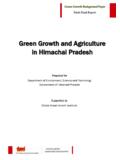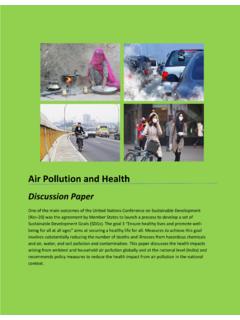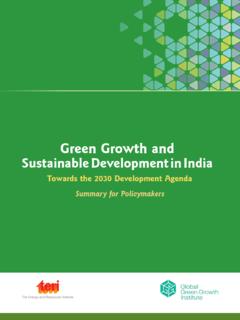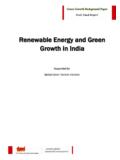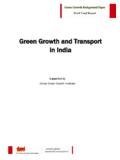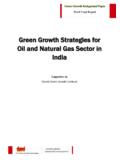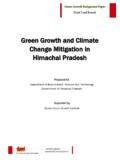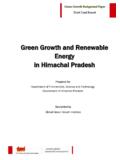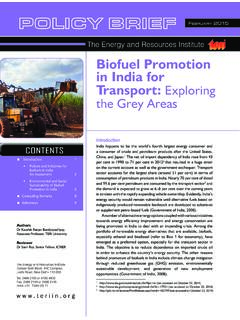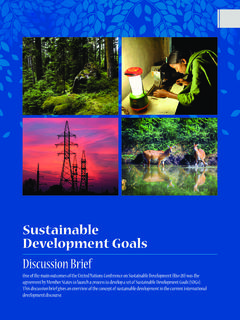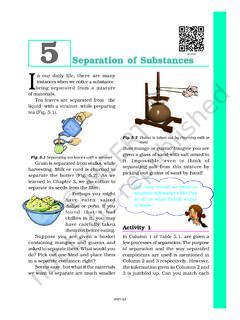Transcription of CROP RESIDUE MANAGEMENT: SOLUTION TO ACHIEVE …
1 DISCUSSION PAPER. January 2020. CROP RESIDUE . management : SOLUTION . TO ACHIEVE BETTER. AIR QUALITY. CROP RESIDUE management : SOLUTION TO ACHIEVE BETTER AIR QUALITY. COPYRIGHT. The material in this publication is copyrighted. Content from this position paper may be used for non-commercial purposes, provided it is attributed to the source. Authors Arindam Datta, Fellow, Centre for Environmental Studies, TERI. Mrinal A. Emmanuel, Project Associate, Centre for Environmental Studies, TERI. N. K. Ram, Senior Fellow & Area Convenor, Renewable Energy Technology Applications, TERI.
2 Sunil Dhingra, Senior Fellow & Associate Director, Renewable Energy Technology Applications, TERI. Reviewers Sumit Sharma, Senior Fellow & Director, Centre for Environmental Studies, TERI. Ajay Shankar, Distinguished Fellow, Director-General's Office, TERI. Acknowledgements Authors greatly acknowledge the support received from Bloomberg Philanthropies. Suggested Format for Citation Datta, A, M A Emmanuel, N K Ram and S Dhingra. 2020. Crop RESIDUE management : SOLUTION To ACHIEVE Better Air Quality. New Delhi: TERI.
3 Design Sushmita Ghosh, Sudeep Pawar, TERI Press PUBLISHED BY. The Energy and Resources Institute (TERI). FOR MORE INFORMATION. Centre for Sustainable Mobility, TERI, Darbari Seth Block, IHC Complex, Lodhi Road, New Delhi 110 003, India |. Tel.: +91 11 2468 2100 or 2468 2111 | Fax: +91 11 2468 2144 or 2468 2145 Email: | Web: TABLE OF CONTENTS. Introduction 1. Current Status of the Sector 2. Prescribed Strategy 5. Acknowledgement 8. References 8. iv DISCUSSION. POLICY BRIEFPAPER. INTRODUCTION. Residents of different cities (probably villages too) of sugarcane ( ) > maize ( ) > cotton ( ) > rice ( ).
4 India breathe some of the least healthy air of the globe. > wheat ( ) (TERI 2019). Crop RESIDUE burning also emit During 2017, about of the population of India SOx, NOx, NH3, and volatile organic compounds (VOCs). were exposed to annual population-weighted mean PM2 5 (Jain, Bhatia, and Pathak 2014) which are precursors greater than the limit recommended by the National for the formation of particulates in the atmosphere. In Ambient Air Quality Standards (NAAQ: 40 mg/m3) addition, Jain, Bhatia, and Pathak (2014) have estimated (Balakrishnan, Dey, Gupta, et al.)
5 2019). Over last five years, that more than Mt of carbon monoxide is emitted to the annual population-weighted mean ambient PM2 5 the atmosphere during the burning of crop residues . concentrations were significantly higher over the Indo- Studies have also reported the several ill-effects of crop Gangetic Plain (IGP) region in comparison to other parts of RESIDUE burning on soil organic carbon and fertility the country. It should also be noted that polluted air is the including reduction in the productivity in the long term second highest health risk factor in India (Balakrishnan, (Hesammi, Talebi, and Hesammi 2014; Ponnamperuma Dey, Gupta, et al.)
6 2019). 1984). All over the globe coal-based power plants, industry, In India, rice is grown in nearly 44 million hector area gasoline or diesel vehicular emission, and natural (NFSM 2016). Food Corporation of India procurs about dusts are regarded as the major sources of ambient air 40% of the total kharif rice ( Mt) from Uttar Pradesh, pollution. There are also certain area-specific and even Haryana, and Punjab of northwestern IGP region, of which season-specific pollutant sources that create regional Punjab alone supplies 60% of this (MoA&FW 2018).
7 More and seasonal air pollution crisis. The seasonal burning than 80% of the agricultural activities in northwestern of crop residues , particularly in the north-western parts India are based on rice-based cropping system (above of the IGP, impose gargantuan effect on the air quality million ha). Cropping system is the cornerstone to of the region as well as on the economy of the country the food security of a country. Traditionally, rice used to through major disruption in transportation, closure of be grown in eastern part of IGP, while wheat was grown schools, and increasing ailment among the productive in the western part of the plain.
8 Introduction of high- population. Studies suggested that the seasonal burning yielding, input responsive, and short duration varieties (particularly during the first 10 days of November) of crop during the Green Revolution of India made it possible to RESIDUE in agriculture fields contribute 30% to 35% of grow both rice and wheat in the same year in one field. PM10 concentration in Delhi (PTI 2019a). But intensive use of these varieties over the decades led During different harvesting seasons, crop residues of rice, to the degradation of the soil quality and over-extraction wheat, sugarcane, maize, cotton , soya bean, mustard, of ground water for rice cropping reduced the levels among others, are burnt in the crop lands in various significantly in the northwestern region.
9 Wheat seeds areas of the country. More than 683 million tonnes (Mt) generally germinate in a temperature range from 20oC. of crop residues of different crops are produced, of to 25oC and during the ripening period, the temperature which a major part is used as fodder, fuel, and in various of 14oC to 16oC is favourable. For matured rice crop, industrial processes. Despite this, about 178 Mt of surplus the harvest temperature is in the range from 20oC to crop residues are available around the country (TIFAC 27oC and the sowing temperature is in the range from 2018).
10 An estimated 87 Mt of surplus crop residues is 30oC to 35oC. Thus, there is an overlapping of ambient burnt in different croplands (TERI 2019). The air pollution temperature during the harvesting season of rice and emission intensity of different crop residues also varies. the sowing season of wheat. As a result of shortage of For example, the emission (g/kg) from the burning groundwater, rice cropping in northwestern India mostly of different types of crop residues follows the order: depends on monsoon which arrives around last week of CROP RESIDUE management : SOLUTION TO ACHIEVE BETTER AIR QUALITY 1.
